Summary
1,25-Dihydroxyvitamin D3 (1,25(OH)2D3) was recently shown to promote maturation of 5-fluorouracil (5FU)-treated bone marrow cells by up-regulating macrophage-colony stimulating factor (M-CSF) receptors in the presence of interleukin la (IL-1α). In order to reveal how 1,25(OH)2D3 interacts with colony-stimulating factors and regulates the differentiation of bone marrow progenitor cell populations, in the present study, natural bone marrow cells were isolated from untreated mice and used in a-minimum essential medium supplemented with 20% heat-inactivated horse serum without added appropriate cytokines. Under the conditions, cells spontaneously differentiated gradually with days of culture, as assessed by expression of macrophage differentiation antigens such as Mac-1 (CD11b) and F4/80. Both M-CSF and granulocyte macrophage-colony stimulating factor (GM-CSF) induced only Mac-1 antigen expression. Simultaneous treatment with M-CSF and 1,25(OH)2D3 enhanced the M-CSF's effect on expression of both antigens, although (1,25(OH)2D3) per se has no effect on the expression for up to 11 days. In addition, successive treatment with 1,25(OH)2D3 and M-CSF or GM-CSF dramatically enhanced expression of both antigens or Mac-1 antigen, respectively. Similarly, both simultaneous and successive treatment with 1,25(OH)2D3 and M-CSF significantly enhanced phagocytic activity and H2O2 production, whereas successive treatment with (1,25(OH)2D3) and GM-CSF significantly enhanced only phagocytic activity. Enzymehistochemical study demonstrated that cells treated simultaneously or successively with 1,25(OH)2D3 and M-CSF were strongly positive for nonspecific esterase (NSE), a macrophage-specific marker, and that simultaneous or successive treatment with 1,25(OH)2D3 and GM-CSF yielded cells strongly positive for NSE or for chloroacetate esterase (ChAE), a granulocyte-specific marker, respectively. These findings suggest that 1,25(OH)2D3 primes bone marrow progenitor cell populations not only to M-CSF but also to GM-CSF and thereby accelerates the CSFs-dependent differentiation of the cells to the macrophage or granulocyte.
Similar content being viewed by others
References
Metcalf D (1986) The molecular biology and functions of the granulocyte-macrophage colony-stimulating factors. Blood 67:257–267
Metcalf D (1991) Control of granulocytes and macrophages: molecular, cellular, and clinical aspects. Science 254:529–533
Clark SC, Kamen R (1987) The human hematopoietic colonystimulating factors. Science 236:1229–1237
Sieff CA, Emerson SG, Donahue RE, Nathan DG, Wang EA, Wong GG, Clark SC (1985) Human recombinant granulocytemacrophage colony-stimulating factor: a multilineage hematopoietin. Science 230:1171–1173
Miyaura C, Abe E, Kuribayashi T, Tanak H, Konno K, Nishii Y, Suda T (1981) 1α,25-Dihydroxyvitamin D3 induces differentiation of human myeloid leukemia cells. Biochem Biophys Res Commun 102:937–943
Bar-Shavit Z, Teitelbauem SL, Reitsma P, Hall A, Pegg LE, Trial J, Kahn AJ (1983) Induction of monocytic differentiation and bone resorption by 1,25-dihydroxyvitamin D3. Proc Natl Acad Sci USA 80:5907–5911
Murao S, Gemmell MA, Callaham MF, Anderson NL, Huberman E (1983) Control of macrophage cell differentiation in human promyelocytic HL-60 leukemia cells by 1,25-dihydroxyvitamin D3 and phorbol-12-myristate-13-acetate. Cancer Res 43:4989–4996
Mangelsdorf DJ, Koeffler HP, Donaldson CA, Pike JW, Haussler MR (1984) 1,25-Dihydroxyvitamin D3-induced differentiation in a human promyleocytic leukemia cell line (HL-60): receptor-mediated maturation to macrophage-like cells. J Cell Biol 98:391–398
Weinberg JB, Misukonis MA, Hobbs MM, Borowitz MJ (1986) Cooperative effects of gamma interferon and 1-alpha,25-dihydroxyvitamin D3 in inducing differentiation of human promyeolcytic leukemia (HL-60) cells. Exp Hematol 14:138–142
Clohisy DR, Bar-Shavit Z, Chappel JC, Teitelbaum SL (1987) 1,25-Dihydroxyvitamin D3 modulates bone marrow macrophage precursor proliferation and differentiation. J Biol Chem 262:15922–15929
Perkins SL, Teitelbaum SL (1991) 1,25-Dihydroxyvitamin D3 modulates colony-stimulating factor-1 receptor binding by murine bone marrow macrophage precursors. Endocrinology 128:303–311
Dodd RC, Cohen MS, Newman SL, Gray TK (1983) Vitamin D metabolites change the phenotype of monoblastic U937 cells. Proc Nall Acad Sci USA 80:7538–7541
Goldman R (1984) Induction of a high phagocytic capability in P388D1, a macrophage-like tumor cell line, by 1α,25-dihy-droxyvitamin D3. Cancer Res 44:11–19
Orikasa M, Kawase T, Shimizu F, Suzuki A (1991) Establishment of murine macrophage-like mutant and hybrid cell lines: comparative analysis of the differentiation induced by 1α,25-dihydroxyvitamin D3 and recombinant murine interferon-τ. Cell Immunol 132:350–365
Cohen MS, Mesler DE, Snipes RG, Gray TK (1986) 1,25-Dihydroxyvitamin D3 activates secretion of hydrogen peroxide by human monocytes. J Immunol 136:1049–1053
Zuckerman SH, Surprenant YM, Tang J (1988) Synergistic effect of granulocyte-macrophage colony-stimulating factor and 1,25-dihydroxyvitamin D3 on the differentiation of the human manocytic cell line U937. Blood 71:619–624
Kawase T, Orikasa M, Suzuki A (1992) Phorbol ester-like action of staurosporine on the cAMP response to prostaglandin E2 in two macrophage-like cell lines at distinct differention stages. Cell Signalling 4:479–485
Springer T, Galfre G, Secher DS, Milstein C (1979) Mac-1: a macrophage differentiation antigen identified by monoclonal antibody. Eur J lmmunol 9:301–306
Ho M-K, Springer TA (1982) Mac-1 antigen: quantitative expression in macrophage populations and tissues, and immunofluorescent localization in spleen. J Immunol 128:2281–2286
Beller DI, Springer TA, Schreiber RD (1982) Anti-Mac-1 selectively inhibits the mouse and human type three complement receptor. J Exp Med 156:1000–1009
Vogel SN, English KE, Fertsch D, Fultz MJ (1983) Differential modulation of macrophage membrane markers by interferon: analysis of Fc and Cab receptors, Mac-1 and la antigen expression. J Interferon Res 3:153–160
Austyn JM, Gordon S (1981) 174/80, a monoclonal antibody directed specifically against the mouse macrophage. Eur J Immunol 11:805–815
Hirsch S, Austyn JM, Gordon S (1981) Expression of the macrophage-specific antigen F4/80 during differentiation of mouse bone marrow cells in culture. J Exp Med 154:713–725
Pick E, Keisari Y (1980) A simple colorimetric method for the measurement of hydrogen peroxide produced by cells in culture. J Immunol Methods 38:161–170
Gately CL, Wahl SM, Oppenheim JJ (1983) Characterization of hydrogen peroxide-potentiating factor, a lymphokine that increases the capacity of human monocytes and monocyte-like cell lines to produce hydrogen peroxide. J Immunol 131:2853–2858
Yam LT, Li CY, Crosby WH (1971) Cytochemical identification of monocytes and granulocytes. Am J Clin Pathol 55:283–290
Roodman CD, Ibbotson KJ, MacDonald BR, Kuehl TJ, Mundy GR (1985) 1,25-Dihydroxyvitamin D3 causes formation of multinucleated cells with several osteoclast characteristics in cultures of primate marrow. Proc Natl Acad Sci USA 82:8213–8217
Takahashi N, Yamana H, Yoshiki S, Roodman GD, Mundy GR, Jones SJ, Boyde A, Suda T (1988) Osteoclast-like cell formation and its regulation by osteotropic hormones in mouse bone marrow cultures. Endocrinology 122:1373–1382
Author information
Authors and Affiliations
Rights and permissions
About this article
Cite this article
Orikasa, M., Kawase, T. & Suzuki, A. Induction of macrophagic and granulocytic differentiation of murine bone marrow progenitor cells by 1,25-dihydroxyvitamin D3 . Calcif Tissue Int 53, 193–200 (1993). https://doi.org/10.1007/BF01321837
Received:
Revised:
Issue Date:
DOI: https://doi.org/10.1007/BF01321837




